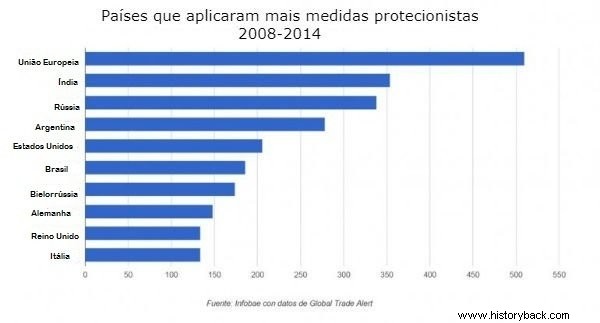The Protectionism it is an economic policy that aims to protect the internal market from external competition.
This policy has been used since the 16th century with Mercantilism and its measures are currently applied by several countries.
Abstract
The main characteristics of protectionism are to make it difficult for foreign products and services to enter to protect the national market.
To achieve this, the government increases import tax rates, creates sanitary, economic and political customs barriers, subsidizes national industry or agriculture.
These measures are intended to prevent the entry of imported products from harming the internal market.
Although it has lost its effectiveness with globalization, several countries still use protectionist measures in favor of increasing profits and the internal market.
This doctrine is supposedly seen as "unfair" by many scholars in the field. On the one hand, the country loses space on the world economic scene. On the other hand, protectionism aims to protect and strengthen the country's domestic economy through the monopoly of the domestic market.
In this way, better living and working conditions are guaranteed for the inhabitants, as well as the increase in job offers and the development of new technologies.
According to the World Trade Organization (WTO), a survey carried out in 2013, Brazil leads the ranking of countries that use too many protectionist laws, which makes foreign trade transactions difficult in certain sectors.

This does not mean, however, that jobs and increased domestic consumption are guaranteed through the application of protectionist laws.
In the opinion of certain economists, there are not many benefits in using protectionist measures in the face of a globalized economic world scenario.
After all, protectionism can generate an increase in domestic products, but also a loss of trade opportunities with countries and delays in the political, social, economic and technological spheres.
Types of Protectionism
Although there is no difference between protectionism and the rates applied in the economic spheres, there are those who divide protectionism in two ways, namely:
- Trade Protectionism :countries set quotas for certain products;
- Customs Protectionism :when the fees for importing the product are high.
Agricultural Protectionism
Agricultural protectionism is characterized by the protection that the government establishes for certain sectors of agriculture.
It is usually done through subsidies, farmer credit facilities and tax breaks. With this, the final product will be cheaper and can be sold in the domestic or foreign market with a more competitive price.
Free Trade
Opposing the theory of protectionism is Free Trade, also called "free trade".
This idea defends that trade between countries should not be restricted, thus facilitating commercial, political and economic exchanges as stated by economic liberalism.
Read more :
- Mercantilism
- Characteristics of Mercantilism
- Trade Balance
- Bourgeoisie
- Financial Capitalism
